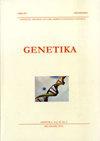Text-11 snps and neighboring sequences role in causing male infertility in some ethnic groups of Iranian and their potential role in estimating divergence time
4区 农林科学
Q3 Agricultural and Biological Sciences
引用次数: 0
Abstract
X-chromosome and its independent loci recently gained importance in genetic investigations concerned with disease control-case studies, population genetic analyses, and phylogenetic investigations. Infertility and lack of normal reproduction are important issues in health. Aazoospermia is a kind of infertility in men whose semen contains no sperm and can affect about 1-20% of the male population. The majority of cases of spermatogenic failure in humans are idiopathic, and the underlying causes are postulated to be genetic. We analyze the potential association between seven X-Chromosome SNPs and the neighboring sequences with azoospermia in four ethnic populations in Iran. We also carried out population genetic analyses to produce data on genetic variability, population structure, gene flow, and time of divergence in these ethnic groups, for the first time. As the X-chromosome genes/SNPs are in homozygous condition, for the association study we used multivariate statistical methods, which revealed the potential role of variable sites close to the studied SNPs in male infertility. Haplotype groups were identified for each of the seven SNPs. The results showed gene flow among ethnic groups due to migration and inter-breeding and Bayesian analysis of sequence data suggested divergence time for ethnic populations to be between 2-30 KY.文本-11 snp和邻近序列在导致伊朗一些民族男性不育中的作用及其在估计分化时间中的潜在作用
最近,x染色体及其独立位点在与疾病控制病例研究、群体遗传分析和系统发育调查有关的遗传调查中变得越来越重要。不育和缺乏正常生殖是健康方面的重要问题。无精子症是一种精液中不含精子的男性不育症,约占男性人口的1-20%。大多数人类生精失败的病例是特发性的,潜在的原因被认为是遗传的。我们分析了伊朗4个民族人群中7个x染色体snp与邻近无精子症序列之间的潜在关联。我们还进行了群体遗传分析,首次获得了这些族群的遗传变异、群体结构、基因流动和分化时间的数据。由于x染色体基因/SNPs处于纯合状态,我们使用多元统计方法进行关联研究,揭示了与所研究SNPs接近的可变位点在男性不育中的潜在作用。对7个snp分别鉴定了单倍型群。结果表明,各民族间存在迁移和杂交导致的基因流动,序列数据的贝叶斯分析表明,各民族群体的分化时间在2 ~ 30 KY之间。
本文章由计算机程序翻译,如有差异,请以英文原文为准。
求助全文
约1分钟内获得全文
求助全文
来源期刊

Genetika-Belgrade
AGRONOMY-GENETICS & HEREDITY
CiteScore
1.80
自引率
0.00%
发文量
1
审稿时长
6-12 weeks
期刊介绍:
The GENETIKA is dedicated to genetic studies of all organisms including genetics of microorganisms, plant genetics, animal genetics, human genetics, molecular genetics, genomics, functional genomics, plant and animal breeding, population and evolutionary genetics, mutagenesis and genotoxicology and biotechnology.
 求助内容:
求助内容: 应助结果提醒方式:
应助结果提醒方式:


